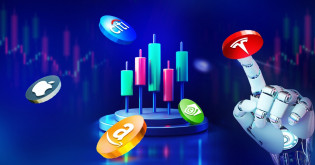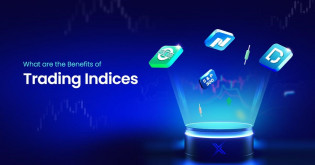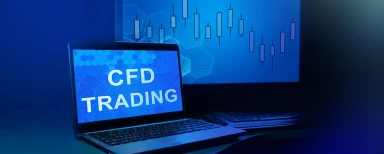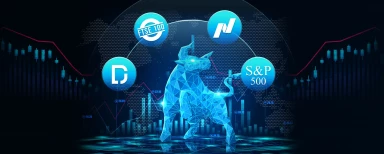-
Forex market is full of several jargons and terminologies. Some of them may seem familiar to you while some of them seems complicated. Before entering the market a trader at least know the basic terminologies so that he can trade hassle free. You might have heard the term “Trade Indices” and “Stock market” frequently mentioned frequently mentioned in media such as television, radio, newspapers, and the internet. The market has performed well today, but what does that mean? What exactly is "the indices"?
When most people discuss "the market," they frequently refer to stock indices. Index names like the Dow Jones Index, SP 500, CAC40, or DAX 30 have become part of our everyday vocabulary as the stock market's significance in our culture has grown.
Trading on indices enjoys a great deal of popularity among participants in the global financial world, and for good reason. Not only do indices make it possible for investors and traders to obtain exposure to a whole economy through a single trade, but they can also be traded in both directions, which means that it is feasible to profit from price swings in either way.
Are you interested in gaining more knowledge about trading indices? This index trading tutorial is an excellent resource for getting started in the indices trading market. In this primer, we will introduce you to the fundamentals of stock indices and discuss the various ways in which you can trade in them.
What is a stock index?
An index that monitors the performance of a particular group of stocks over a period of time is referred to as a stock index.
The purpose of stock indices is to give investors a method that is both accurate and efficient with which they may compare current stock market prices with historical stock market values in a reliable manner. Indices are a useful tool for measuring the overall performance of the stock market as well as the success of individual investors in comparison to other investors.
The following are some examples of stock indices:
- The S&P 500 index, which follows the performance of 500 large-cap businesses listed in the United States and is often regarded as a comprehensive representation of the stock market in the United States, tracks the performance of these companies.
- The FTSE 100 index, which monitors the performance of 100 large-cap stocks that are listed in the UK and is the indicator that is used the most frequently in the UK stock market,
- The Nikkei 225 index is the most well-known stock market index in Japan. It follows the performance of 225 of the most important firms that are listed in Japan.
Note: Direct investment in indices is not possible. Nevertheless, you have the opportunity to profit from the fluctuations in their prices if you trade financial items that mirror their performance, such as contracts for difference (CFDs).
Different kinds of stock indices
Today's financial markets make use of a diverse range of stock market indices.
The following are some of the most common types:
Country-focused indices
These are intended to serve as a reflection of the stock markets of particular nations. For instance, there is the Standard & Poor's 500 Index, which is widely believed to be a comprehensive depiction of the stock market in the United States, and there is the DAX 30, which is generally considered to be a barometer of the economy in Germany.
Exchange-based indices
These are made to follow the stocks on a certain stock exchange. The NASDAQ 100 index, which tracks non-financial stocks on the NASDAQ exchange, is a good example.
Regional stock indices
These are intended to symbolise particular geographical regions. Examples are the FTSE Developed Asia Pacific Index, which measures the performance of stocks listed in developed Asian countries, and the EURO STOXX 50 index, which measures the performance of European stocks.
Sector-based indices
These are constructed to follow the performance of specific segments of the stock market, such as the healthcare industry or the finance sector, for example.
There are also market-cap-weighted indices and price-weighted indices for stock indices. With market-cap-weighted indices, companies with larger market capitalisations (the entire value of a company's shares) have a greater index weight. The FTSE 100 and DAX30 are examples of market capitalization-weighted indices. With price-weighted indices, companies with more expensive shares have a greater impact on the index. The Dow Jones Industrial Average is a price-weighted index.
Which indices are the best to trade?
There are numerous stock indices available for trading at now. Among the most popular indices among traders are the following:
The Dow Jones Industrial Average (DJ30)
It is one of the oldest stock indices in the world, having been established in 1885. It consists of 30 significant publicly traded corporations in the United States. Index components include Microsoft, Walmart, and Johnson & Johnson, among others.
The S&P 500 index (SPX500)
The S&P 500 is a broad index that measures the performance of 500 US-listed large-cap firms. It is largely regarded as a comprehensive representation of the U.S. stock market. The index includes stocks such as Apple, Mastercard, Walt Disney, and PepsiCo.
The NASDAQ 100
It follows the 100 largest non-financial companies listed on the NASDAQ exchange. This index includes Amazon, Facebook, Alphabet (Google), and Netflix, among other well-known corporations.
The FTSE 100 index (UK100)
The FTSE 100 is a collection of 100 London Stock Exchange-listed large-cap stocks. Royal Dutch Shell, HSBC Holdings, Unilever, and GlaxoSmithKline are among the constituents. While the FTSE 100 is often regarded as the most important stock index in the UK, it is important to note that the majority of companies inside the index generate revenue outside the UK. This indicates that the index does not accurately reflect the British economy.
The DAX 30 (GER30):
This index follows 30 of the largest German firms listed on the Frankfurt Stock Exchange. It is often regarded as an indicator of the German economy. Constituents include Siemens, Adidas, and Volkswagen.
The Nikkei 225 (JPN225)
The Nikkei 225 is the most important stock market index in Japan. It is composed of 225 companies that are listed on the Tokyo Stock Exchange. Included in the index are well-known Japanese companies such as Sony, Toyota, and Panasonic.
The ASX 200 (AUS200)
The ASX200 is the blue-chip stock index in Australia. It follows 200 firms that constitute around 80% of Australia's total market capitalization. ASX200 companies include National Australia Bank, Qantas Airways, and Rio Tinto, among others.
Why trade indices online?
There are many reasons why online indices trading is popular. The following are some of the key benefits of trading indices:
- Trading possibilities are plenty because stock indices are constantly moving in both directions during market hours, and traders and investors always have lots of chances to profit from the market's activity.
- The opportunity to trade in both directions: when you trade indices with CFDs, you have the power to trade in both directions of the market. You can "go long" on an index, which means to purchase it, in order to profit from an increase in its price, or you can "go short" on an index, which means to sell it, in order to profit from a decrease in its price.
- To get started in trading, you need only a modest amount of capital. One of the primary benefits of CFDs is that they provide you with the ability to utilise something called "leverage" to control a larger amount of money than you have actually invested for the trade. For instance, if you use the leverage of X2, you will be able to control $2,000 with only $1,000. This indicates that you can begin trading indices with a capital investment that is on the lower end of the spectrum.
- Your advantages can be magnified through the use of leverage, which is a strong technique that can potentially increase your profits from trading. However, because leverage can potentially raise your losses, it is essential to be aware of the hazards involved.
- Less bother than trading individual stocks: when you trade indices, you don't need to worry about studying specific firms' reports or analysing their financials before you trade. This reduces the amount of work that you have to put in before each transaction. Because of this, trading indices can be a more time-efficient investment strategy than trading individual equities.
- Trading indices is often considered to be less risky than trading individual stocks because, in essence, you are trading an entire portfolio of equities rather than a single stock at a time. This means that you are less vulnerable to the dangers that are associated with specific companies.
How to trade indices?
- Determine how to trade indices
- Choose between trading cash indices or index futures
- Create a login and account
- Choose the index you intend to trade
- Choose between long and short
- Set your limits and stops
- Observe and maintain your position
1. Determine how to trade indices
You are able to trade indices using CFDs when you choose CapitalXtend. Because CFDs are considered to be financial derivatives, you can use them to bet on the value of indices both when they are increasing and when they are decreasing.
2. Choose between trading cash indices or index futures
You can trade cash indices or index futures to get a piece of an index's price.
- Cash indices: They are preferred by day traders and other traders with a short-term focus because their spreads are tighter than those of index futures. Cash indices are traded at the spot price, which is calculated by adding fair value to the price of the front month's futures. To avoid paying overnight funding charges, many traders close their cash indices positions at the end of the trading day and open new ones the next morning.
- Index futures: The are often the best choice for traders who have a long-term view of the market. This is because, even though they have wider spreads than cash indices, they also include the charge for overnight funding. Index futures are traded at the futures price, which is the price that traders agree on now for a future delivery. If you plan to keep an index position for a long time, trading index futures will save you from having to pay overnight funding charges often.
3. Create a login and account
You can start with creating an account with a broker and proceed through verifying your profile via document submission.
4. Choose the index you intend to trade
Choose a trading-style-appropriate index. This depends on your risk tolerance, available capital, and preference for short- or long-term investments.
5. Choose between long and short
Going long means you're speculating on an index's value increasing and going short suggests the opposite. If an economy or sector's prospects looks bright based on an index's performance, a long position may help you profit if the index rose in value. If the prognosis is unfavourable, maybe because significant companies on a capitalization-weighted index are underperforming, you may wish to short the index.
6. Set your limits and stops
Stops and limits are critical for indices risk management. A stop order closes your position automatically if it falls below the current market price, whereas a limit order does the opposite.
7. Observe and maintain your position
When you feel ready to start trading indices, it's time to open a trade. To do this, go to the market you want to trade on through a broker. Next, decide if you want to trade at the cash price or the futures price. If you think the price will go up, choose "buy," and if you think it will go down, choose "sell." Enter the size of your position, and then click "place deal" to start the trade.
Summary
A stock index is a way to measure how well a group of stocks has done over time. The goal of stock indices is to give investors a quick and accurate way to compare current stock market prices to prices from the past. They can be used to measure the performance of the stock market as a whole, as well as an investor's performance. Indices trading is common for more than one reason. With Contracts For Difference, you can trade indices in both directions and take advantage of their many trading opportunities (CFDs).
There are different kinds of stock indices, such as those that are specific to a country, based on an exchange, based on a region, or based on a sector.
The Dow Jones Industrial Average, the S&P 500, the FTSE 100, the DAX 30, and the Nikkei 225 are some of the most-traded indices.




